Crowell-Collier Publishing Company
Crowell-Collier Publishing Company was an American publisher that owned the popular magazines Collier's, Woman's Home Companion and The American Magazine. Crowell also published general interest books and references such as Collier's Encyclopedia and the Harvard Classics series of books.
| Status | defunct (1973) |
|---|---|
| Founded | 1877 |
| Founder | Phineas P. Mast |
| Successor | Macmillan Inc. |
| Country of origin | U.S. |
| Headquarters location | Springfield, Ohio, later New York City |
| Distribution | National |
| Publication types | Magazines, Reference books |
| Owner(s) | P. P. Mast (1877–1898) John S. Crowell (1898–1906) Joseph P. Knapp and George Hazen (1906–?) |
The company was founded by agricultural tool manufacturer P. P. Mast with a single magazine, Farm & Fireside (later the Country Home) to sell farm tools and implements in 1877 in Springfield, Ohio. By 1881, Mast had relinquished control to John S. Crowell who expanded their company by purchasing Home Companion (later changing the name to Woman's Home Companion).
After P. P. Mast's death in 1898, Crowell obtained control of the company and established it as the Crowell Publishing Company. Crowell Publishing expanded their magazine holdings with The American Magazine in 1911 and the weekly Collier's in 1919. At one point Collier's weekly had over 1.25 million subscribers. Crowell's also published the Collier's Encyclopedia which came under fire from the FTC in 1940 for deceptive sales practices.
After shuttering the magazine operations in the 1950s, the Crowell-Collier Publishing Company merged with the American Macmillan Company in 1960 and became a large educational company with subsidiaries for books, textbooks, correspondence schools and other educational tools and materials. The company officially changed its name to Macmillan, Inc. in 1973.
Early History
_p685_SPRINGFIELD%2C_P.P._MAST_%26_CO.jpg)

_p678_SPRINGFIELD%2C_MAST%2C_CROWELL_%26_KIRKPATRICK.jpg)
The Crowell-Collier Publishing Company had its roots in the agricultural trade of the 19th century. Industrialist Phineas P. Mast, the owner of P. P. Mast, manufactured farm and agricultural tools, and he wanted a magazine to promote his products.[1] Mast made wind engines, pumps, plows and mowers in Springfield, Ohio.[1] Mast hired John S. Crowell away from the successful Home and Farm of Louisville in 1877 to manage the new bi-monthly farm journal called Farm & Fireside.[2][3] By the 1890s, Farm & Fireside maintained a circulation of over half a million.[3] Mast relinquished his role as acting executive in 1879, but he stayed on as an investor. Crowell along with T.J. Kirkpatrick (who was Mast's nephew) then changed the name of the publishing house to Mast, Crowell and Kirkpatrick Publishers.[2]
The publishers soon expanded from the one magazine into other markets. They constructed the Farm and Fireside building in Springfield, Ohio, in 1881.[2] In 1883, they purchased the Home Companion magazine from a Harvey & Finn of Cleveland, Ohio to meet the growing demand for content aimed at women.[4] They bought Youth's Home Library, a similar paper that had been published in Boston, and merged it with their youth-oriented publication Our Young People. They then changed the name of the three merged periodicals back to the title Home Companion, a general family magazine. By 1890 the magazine's subscription had reached 100,000.[4] The Companion had a number of names but was changed to Woman's Home Companion in 1896. By the 1890s, Farm & Fireside was also publishing regional editions of the periodical.[3] After the death of P. P. Mast in 1898, the company changed the name to Crowell and Kirkpatrick Publishers.[2]
20th century
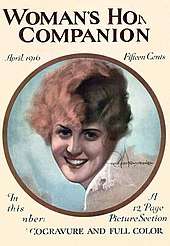
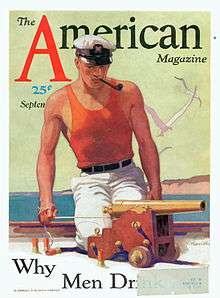

As the 20th century began, the company changed hands again and moved into mainstream magazine publishing. P. P. Mast died in 1898 (leaving an estate of a million and a half dollars).[4] In 1902, John S. Crowell obtained Kirkpatrick's interests and established it as the Crowell Publishing Company.[2][4] In 1906, Crowell turned around and sold his interest in the company to Joseph P. Knapp and George Hazen of New York, who incorporated in New Jersey and kept the name Crowell Publishing Company.[2][5] The new company maintained offices in New York City in addition to Springfield, Ohio.[6]
Crowell Publishing Company lost a 1908 appeal before the Board of United States General Appraisers and were assessed countervailing duties on paper imported from Canada.[7]
1910s and Acquisition of Major Periodicals
Crowell Publishing acquired The American Magazine in 1911 from the Phillips Publishing Company.[2][5][6][8] The magazine had muckraking roots but with the decline of muckraking journalism it had turned into a general interest magazine.[2] However, an article in the New York Times noted that "the purchase of the American Magazine by Crowell Publishing Company meant that 'the interests' were bent on swallowing up the muckrakers..."[9] They pointed to the fact that one of the heavy stockholders in the Crowell firm was Thomas W. Lamont who was also a partner of the newly formed J. P. Morgan & Company. Cleveland Moffett, a known muckraking journalist was quoted, "...we are up against the powers of darkness. The right of free speech in America is in jeopardy. They are trying to muzzle the magazines. Several magazines have changed hands recently.[9] They have come under the control of interests, and in each of them the muckraking features will cease. Muckraking, in spite of its name, is a power in this country, standing as it does to promote good citizenship."[9] However, a second New York Times article about the acquisition stated that writers such as Ida Tarbell, Peter F. Dunne, and William Allen White were pleased with the opportunity.[8] A spokesman from Phillips said that "...instead of reaching 300,000 readers, we can now reach 3,000,000 readers through our new allies in the publication field. We ourselves were afraid the Trusts were behind the proposition before we looked into it, but all the magazines we affiliate with are insurgent like ourselves, and controlled by persons of insurgent sympathies."[8]
That same year, several magazine publishers including Crowell were accused of conspiring to keep up magazine prices through the Periodical Clearing House. According to John Wood, a magazine man whose business had been severely impacted, the Periodical Clearing House was organized by law clerks and employees of the magazines.[10] Wood claimed that ruinous fines had impacted his ability to sell subscriptions. At the same time libraries in the Central Western and Western states complained that the clearing house caused the cessation of club rates on magazines to libraries.[10]
In 1919, the Crowell Publishing Company bought another general interest magazine, Collier's: The National Weekly, and assumed control of Collier's book publishing.[11] Collier's also had roots in muckraking journalism and social reform and had one of the largest magazine subscription audiences, then around one million weekly.[5] The book-publishing arm published popular and serious literature topics as well as the Collier's Encyclopedia and published six million copies a year of books.[5]
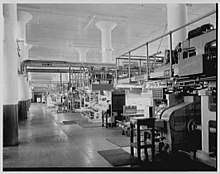

1920s
By 1924, the weekly circulation of Collier's had grown to 1,250,000.[12] Crowell moved its print operations to Springfield, Ohio, because of "excessive postage involved in mailing from a seaboard city under wartime postal rates".[12] The editorial and business departments remained in New York.[12]
1930s
In 1930 Farm & Fireside magazine changed its name to The Country Home.[2] Also in 1930, the Crowell Publishing Company and P. F. Collier and Sons were sued for libel by R.B. Creager, a Republican National Committeeman for Texas. Creager sought $500,000 in damages after an article titled "High-Handed and Hell-Bent" appeared in Collier's Weekly. The article by Owen P. White covered a political situation on the Mexican border in Hidalgo County. The jury returned a verdict for Crowell Publishing.[13]
In 1939, Crowell Publishing merged the New York operations and changed the company name to The Crowell-Collier Publishing Co.[4][14] That same year, The Country Home was discontinued.[15][16]
1940s
In 1940 the FTC investigated the sales methods used for the Collier's Encyclopedia. The publishing company and its officers and directors of the corporations were charged with misleading sale methods and representations in the sale of books and encyclopedias. The complaint charged that "contrary to claims made, none of the respondents' publications is ever given as the result of a drawing or free, and as a gift or gratuity; that the purchase price of so-called free goods is, in every instance, included in the price of other merchandise sold to the customer; that in no case do they sell at actual cost, that the sum of $59 represented as a reduced price is the regular price, and that other claims are 'also deceptive and misleading.'"[17]
During World War II, Crowell-Collier sponsored publication of a magazine for servicemen called Victory.[18]
In 1946, the Vanderbilt mansion at Fifth Avenue and Fifty-First Street was slated to be razed and replaced with a 19-story office building for the Crowell-Collier Publishing Company.[19]
1950s financial reverses
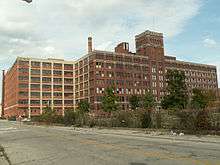
In the mid-1950s, Crowell-Collier had heavy deficits and discontinued The American Magazine, Collier's, and Woman's Home Companion.[2] In December 1956 the company closed its Springfield plant, which at one point had employed more than 2,000 people.[2] The closing shocked both publishers and readers.[21] Many in the magazine field deemed the closing "a foolish and impetuous move",[22] but as the company moved to reinvent itself as a producer of books and educational materials, the move was seen as shrewd and far-visioned.[22]
1960s and reinvention as educational publisher
By the early 1960s, Crowell-Collier had recovered financially. Leaving behind its roots in magazine publishing, it now turned to the growing market for education produced by the baby boom in the United States. Book sales had surged for reference books, textbooks, and encyclopedias and like many of the large publishers of that era such as Random House and Simon & Schuster, Crowell-Collier embarked on a merger and acquisitions spree.[23][24] Crowell-Collier kicked off the decade by merging with the American Macmillan company and moved into the educational space. This was then followed by a number of mergers and acquisitions.[25] On the move into education, Chairman Raymond C. Hagel said, "We envision our major role as that of a developer of complete educational systems." He explained that an educational system was a "unified instructional package involving a variety of tools." and that "the business of education has become a successor to the defense industry. It is a security lifeline."[26] Crowell would end the decade as Crowell Collier & Macmillan, a large conglomeration of subsidiaries that included books, schools, magazines, educational tools, bookstores, book clubs and radio stations and with an annual revenue of $390 million.[27]
Merger with Macmillan
In December 1959, Crowell-Collier acquired 29 percent of Macmillan Company[23][28] which published fiction, non-fiction, textbooks, reference books, religious books and children's books.[29] By August 1960, Crowell-Collier held a 52.8 percent interest in Macmillan,[28] and on December 30, 1960, the companies merged.[30]
Macmillan was once the American division of the British Macmillan Publishers (opened in 1869) and had been run by generations of the Brett family who eventually bought the company from the British in 1896. Macmillan published some notable authors including Jack London, Margaret Mitchell, and Winston Churchill.
At the time, the majority of Macmillan's sales came from textbooks[24][31][32] and for Macmillan the merger meant access to cash and capital to grow their textbook market.[24] Crowell-Collier ran Macmillan as a subsidiary but in 1965 Crowell-Collier officially changed its name to Crowell Collier & Macmillan, Inc.[33] Publishing was dropped from the company name to reflect its broadened scope into education.[34]
Encyclopedias, books and educational materials
Textbooks and encyclopedias were a booming business in 1959. While general books accounted for $408 million in sales, textbooks and encyclopedias totaled $597 million.[24] Crowell's subsidiary P. F. Collier and Sons published the Collier's Encyclopedia and released a new 24-volume set in 1962.[35] Since 1909 it also published the 51-volume Harvard Classics, an anthology of classic and world literature.[35] The company expanded the line of encyclopedias by announcing that it would use the resources of Crowell-Collier, Macmillan and Free Press to begin work on a new multi-volume set on social sciences.[36] W. Allen Wallis, named chairman of the editorial board for the encyclopedia said, "In the past few years we have stressed the physical sciences because of our concern for defense, and the biological sciences because of our interest in better health. Perhaps of even greater importance to the continued survival of our country and, therefore, the whole free world, will be our ability to solve some of the great social problems of the day."[36]
The Federal Trade Commission again cited Crowell-Collier and subsidiary P. F. Collier and Sons with making false claims through the door-to-door salesmen of the encyclopedias.[37] In an article on stockholder questions in The New York Times, shareholders at a meeting in 1963 complained about tactics used by door-to-door encyclopedia salesmen.[38] Nine years later in 1969, the F.T.C. ordered the distributors of Collier's Encyclopedias to stop the use of deceptive sales promoting the publication. The agency charged the company with "Implying through promotional literature and door-to-door salesmen that a set of the encyclopedias would be given free or at a reduced price if yearly supplements were purchased."[39]
In 1960, Crowell began to expand further into general book markets. Collier Books, the paperback division of Crowell-Collier Publishing Company, began publishing in October 1961 at the rate of 50 paperback titles a month.[40][41] The list included scholarly books, nonfiction and fiction reprints and original works.[41][42] Crowell-Collier Press was a hardcover publisher started in 1962 with a focus on adult nonfiction and children's books.[40] The children's series, the Modern Masters Books for Children, was edited by anthologist Louis Untermeyer and included picture books by Robert Graves (The Big Green Book), Shirley Jackson (9 Magic Wishes) and Phyllis McGinley (The B Book).[43] The books were created using a controlled vocabulary of fewer than 800 words created by elementary educators.[44]
In 1962, Crowell also purchased book club distributor Scientific Materials, Inc., which included Library of Science, Science Book Club, Natural History Book Club, and Basic Book Service. In addition to the four professional level book clubs, two others aimed at young adults including the Young Adults' Division and Junior Scientists Division of the Library of Science were also a part of the acquisition. Crowell-Collier later that same year turned around and sold the toy manufacturing arm of Scientific Materials, Inc. to Allis-Chalmers manufacturing[45][46]
In 1962, Crowell made another push into the book market with a purchase of book clubs and retail bookstores. In the same year, they purchased 16 Brentano's bookstores. At the time bookstores were heavily competing with department stores and discount houses offering reduced rates for bestsellers.[47] By 1967, the Brentano's chain had grown to 21 stores and had sales of $7 million.[48]
In 1962, Crowell-Collier Publishing Company created a new division called Crowell-Collier Educational Corporation. The educational arm was created to develop instructional and reference materials as well as teaching aids for us in schools, colleges, adult education, business, and industrial training and home study.[49]
Other acquisitions included the following:
- English Language Services, Inc. (1962), instructional materials used abroad to teach English-as-a-second language.[50]
- Publication Corporation (1968)[51]
- Associated Films, Inc. (1968), an educational film distribution company[51]
- Bruce Publishing Company (1968), a publisher of Catholic religion and educational books.[52]
- P.J. Kenedy & Sons (1968), a publisher of Catholic religion and educational books.[53]
- Hagstrom Company, Inc (1968), creator of educational materials and services.[54]
- Fleetwood Films, Inc. (1968), films for home and educational use.[54]
- Pandex, Inc, (1968) a reference company.[54]
- Brandon (1968), another education and film distribution company.[55]
- G. Schirmer, Inc.,(1968) a music and publishing company
- Studio Vista, Ltd. (1968)—British publisher of books on graphic arts, architecture and design.[56]
- Geoffrey Chapman, Ltd. (1968)-British publisher of Catholic books[57]
- Benziger Brothers (1969)—publishers of religious and education books.[58]
- Cassell & Co. Holdings, Ltd, (1969). a British publishing company.[59]
- Standard Rate & Data Services, Inc., a publisher of advertising and marketing data, and National Register Publishing, a directory publisher.[60]
Home study and vocational training
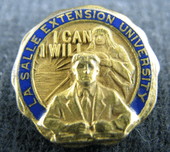
Vocational training became big business in the 1960s as companies attempted fill a void between a high school diploma and college degrees and Crowell-Collier made significant acquisitions expanding into this market.[61] In 1960, Crowell purchased the La Salle Extension University—a correspondence school.[25][26] In 1965 Crowell Collier & Macmillan, Inc. purchased Berlitz Schools of Languages of America, Inc.and Berlitz Publications for $5 million.[62][63] Crowell purchased Katherine Gibbs School, Inc. a secretarial school.[64] It also attempted to acquire Famous Artists Schools, Inc. a writing and art correspondence school by purchasing 25% of shares which it later sold to institutional investors in 1968.[65][66]
In 1969, Crowell filed a lawsuit against National Home Study Council of Washington which was a private accrediting agency. The suit said that National Home was a monopoly and had denied re-accreditation to the U.S. School of Music, Inc. and La Salle Extension University.[67] By 1969, Crowell made 22% of its revenue from La Salle Extension University, Berlitz, and Katharine Gibbs.[68] The lawsuit settled but at the same time, the entire mail-order schooling came under fire from the New York Times for dubious practices including "overblown advertising, fast talking salesmen, questionable instruction and marginal results."[69]
Return to magazines
In 1968 the company merged with Publication Corporation, a leading printer of Sunday magazines for newspapers and the publisher of This Week magazine. The companies had a shared history—Joseph P. Knapp, who had helped develop the Crowell Publishing Company, had founded Publication Corporation as American Lithograph Company in 1891. The Publication had also been a principal stockholder of Crowell-Collier—owning 24% at one point.[70] The goal for the merger was to distribute periodicals efficiently in the education market.[70] By 1969, Crowell made the decision to shut down the This Week magazine which had a circulation of 9 million as a weekend supplement for papers such as The Providence Journal and the Kansas City Star.[71]
In 1969 Crowell Collier & Macmillan went back to publishing magazines but with a focus on education.[72] They acquired six magazines including Grade Teacher, the Catholic School Journal, Industrial Arts and Vocational Education, College Management, School Management and Business Management.[72] These magazines made up a subsidiary CCM magazines based in Greenwich, Conn.[72]
Other media
Crowell-Collier Broadcasting operated radio stations in Los Angeles (KFWB), San Francisco-Oakland-San Jose (KEWB) and Minneapolis-St. Paul (KDWB).[31][73]
In 1969 Crowell-Collier purchased the Gump's store in San Francisco.[74]
Crowell-Collier purchased C.G. Conn a manufacturer of musical instruments in 1968.[75]
In 1966 the company consolidated 1400 employees into a new building on 866 3rd Avenue called the Crowell Collier & Macmillan building.[76]
1970s
By the start of the 1970s, Crowell Collier & Macmillan was now a $400 million multinational producer of books and educational materials.[77] Crowell Collier & Macmillan decided to change the name of the company to Macmillan, Inc. First, though, they encountered a legal battle over the name with Macmillan, Ltd. of London—who had spun-off from the original American Macmillan in 1896. For the name to take effect on January 1, 1973,[78] the companies agreed to some conditions including the American company using Crowell-Collier or another name to distinguish the businesses in which the British Macmillan operated. The British Macmillan stated that the name had already been causing confusion with the public resulting in misdirected book orders and the fear that the American company was planning to use the name to compete unfairly in markets where the British company was active. The case cited the Lanham Act, the trademark act of 1946.[77]

This was not the only legal battle that the now Macmillan, Inc. faced at the start of the seventies. Macmillan sued Charles F. Berlitz, grandson of the founder of Berlitz to prohibit him from using the Berlitz name in travel and writing businesses.[79] Berlitz won the lawsuit and was awarded $376,000 and the right to use his name as an author of books on foreign languages.[80] The Justice Department filed a civil anti-trust suit against Crowell, Collier & Macmillan, Inc. in 1970 and requested that it divest itself from C.G. Conn, Ltd (a manufacturer and retailer of musical instruments) and Uniforms by Ostwald, Inc. (manufacturer and retailer of band uniforms).[81]
Crowell-Collier was also under fire by the FTC again in 1972 and accused of using deceptive practices in selling its Harvard Classics and in billing encyclopedia buyers and also in recruiting of encyclopedia salesmen. Of the Harvard Classics, the FTC stated that while the company marketed that one or several volumes were offered free or for $1 each "with the understanding that additional volumes priced at $3.98 would be shipped periodically for free examination", many volumes would be shipped in a bulk shipment. Buyers were subjected to repeated mailings of bills. Crowell responded that they had already discontinued the Harvard Classics "continuity" program and that any "isolated" occurrences or procedures had been changed. For the encyclopedias, Crowell was accused of raising the price on Encyclopedia annual supplements called Yearbooks. They were also accused of advertising positions for encyclopedia salesman as "administrative assistant trainees" and "marketing and public relations personnel". Crowell issued a statement disavowing any violations but agreed to negotiate a consent order.[82]
Martin Gardner protesting Crowell-Collier's publishing of the psychic surgeon John G. Fuller's book Arigo withdrew publication of his own (Gardner) book.[83]
Magazines
- Farm & Fireside (1877–1939): The early content of this magazine advertised agricultural implements manufactured by P. P. Mast & Co.[2] When farming became a commercialized industry, Farm & Fireside changed to address it commercial and economic aspects[2] and provided a first-hand account of America's conversion from a rural to an urban population.[2]
- Woman's Home Companion (1883–1950): The popularity of the women's section of Farm & Fireside created a demand for a publication dedicated to women. The company acquired The Home Companion magazine in 1883 and changed the name to Ladies Home Companion and then later to Women's Home Companion.[2]
- The American Magazine (1911–1956): The magazine began as Leslie's Popular Monthly in 1876 and was then sold in 1906 to muckrakers Ray Stannard Barker, Ida Tarbell, and Lincoln Steffans. The periodical addressed the hopes and aspirations of the ordinary man was purchased by Crowell-Collier in 1911.[2]
- Collier's (1919–1956): The magazine was originally established by Peter Fenelon Collier in New York in 1888. It was purchased by Crowell Publishing in 1919[2] and ceased publication in 1956.[84]
- The Mentor (1921–1930): This magazine focused on topics including science, art, history, literature and travel. The Mentor merged with the World Traveler in 1930 as the Mentor-World Traveler and ceased publication that same year.[2]
References
- "Phineas P. Mast – clarkcountyhistory". clarkcountyhistory.wordpress.com. Archived from the original on 2016-10-12. Retrieved 2016-04-23.
- "Chronology". www.subscriptiontoamerica.org. Archived from the original on 2016-03-08. Retrieved 2016-04-17.
- Mott, Frank Luther (1930). A History of American Magazines, Vol. IV. Cambridge, MA: Harvard Press. p. 337. ISBN 9780674395503.
- Mott, Frank Luther (1957). A History of American Magazines, Vol IV. Harvard Press. pp. 769–772. ISBN 978-0674395503.
- "Crowell-Collier Publishing Company Records, 1931-1955" (PDF). Guide to the Crowell-Collier Publishing Company Records. The New York Public Library Humanities and Social Sciences Library Manuscripts and Archives Division. Archived (PDF) from the original on March 4, 2016. Retrieved April 23, 2016.
- "The Iliad of Homer". The New York Times. 1911-02-12. ISSN 0362-4331. Retrieved 2018-06-07.
- "LATEST CUSTOMS RULINGS.; Countervailing Duty Accrues on Printing Paper -- Other Tariff Decisions". The New York Times. 1908-04-01. ISSN 0362-4331. Retrieved 2018-06-07.
- "ELEVATED AGENTS ROBBED.; Lone Highwayman Holds Up Two Station -- Gets All Receipts In one". The New York Times. 1911-02-02. ISSN 0362-4331. Retrieved 2018-06-08.
- "PARTNER OF MORGAN IN MAGAZINE FIRM; Thomas W. Lamont One of the New Owners of the American Magazine". The New York Times. 1911-02-05. ISSN 0362-4331. Retrieved 2018-06-08.
- "ACCUSES MAGAZINES OF TRADE RESTRAINT; Club Rate Agent Says the Leading Publishers Are in a Conspiracy to Keep Up Prices". The New York Times. 1911-06-25. ISSN 0362-4331. Retrieved 2018-06-07.
- "The New York Times: Saturday July 26, 1919". timesmachine.nytimes.com. Retrieved 2016-04-17.
- "COLLIER'S PLANT TO MOVE TO OHIO; Publication Follows Others That Have Left New York Because of Union Conditions. POSTAGE ALSO AN ITEM To Be Printed Under "Open Shop" Regulations at Springfield -- Bernarr-McFadden May Go". timesmachine.nytimes.com. Retrieved 2016-04-17.
- "CREAGER LOSES SUIT AGAINST COLLIER'S; Republican Leader in Texas Sought $500,000 Damages for Story in Magazine". timesmachine.nytimes.com. Retrieved 2016-04-17.
- "Advertising News and Notes; Newspaper Campaigns Listed". timesmachine.nytimes.com. Retrieved 2016-04-19.
- "Magazine Will Suspend". timesmachine.nytimes.com. Retrieved 2016-04-18.
- "Advertising News and Notes; Drake's Cake in Newspapers". timesmachine.nytimes.com. Retrieved 2016-04-19.
- "CROWELL CITED BY FTC; Complaint Charges Book Sales Methods Were Misleading". timesmachine.nytimes.com. Retrieved 2016-04-18.
- "COPIES OF 'VICTORY' SENT TO SOLDIERS; OWI Office Letter Obtained by Senators Gives Details of Budget and Plans ADVERTISING EXPLAINED Success of 'Signal,' German Propaganda Organ, Caused Agency's Counter-Attack". timesmachine.nytimes.com. Retrieved 2016-04-19.
- "Passing of the Marble Front". timesmachine.nytimes.com. Retrieved 2016-04-19.
- Newton, Riley. "'Our grandchildren will call us foolish': Crowell-Collier buildings to be demolished". Springfield News-Sun. Springfield, Ohio. Retrieved September 2, 2019.
- "The New York Times: Sunday June 17, 1962". timesmachine.nytimes.com. Retrieved 2016-04-23.
- "Advertising: Books and Magazines Merging; Publishing Trend Is Shown by Recent Developments. Impact on Finance Editorial Content Is Fundamental Latest in a Series Line Discontinued Other Reports Another Venture". timesmachine.nytimes.com. Retrieved 2016-04-23.
- "RECENT MERGERS ALTER BOOK FIELD; Holt and 2 Other Concerns Exchanging Stock -- Text House Also in Deal". The New York Times. April 17, 1960. Retrieved 2016-04-21.
- "Publishers of Books Are Turning to Mergers; Some Stocks Listed and Advertising Drives Pushed BOOK PUBLISHING IS TURNING A LEAF". timesmachine.nytimes.com. Retrieved 2016-04-22.
- "The New York Times: Wednesday December 20, 1961". timesmachine.nytimes.com. Retrieved 2016-04-20.
- "Personality: Diversifier in Publishing Field; Crowell Collier Head Sets a 'Pattern for Future'". timesmachine.nytimes.com. Retrieved 2016-04-21.
- "Goodyear Rubber and R.J. Reynolds Profits Rise". timesmachine.nytimes.com. Retrieved 2016-04-24.
- "CROWELL-COLLIER". [The New York Times. August 4, 1960. Retrieved 2016-04-20.
- "MERGER IS VOTED FOR PUBLISHERS; Stockholders of Macmillan and Crowell-Collier Back Exchange of Shares". timesmachine.nytimes.com. Retrieved 2016-04-20.
- "Crowell-Collier Publishing Company records 1931–1955". New York Public Library. Archived from the original on 2016-08-22. Retrieved 2017-07-03.
- "MERGER IS VOTED FOR PUBLISHERS; Stockholders of Macmillan and Crowell-Collier Back Exchange of Shares". timesmachine.nytimes.com. Retrieved 2016-04-21.
- "Book Trade Upset by Changes in Ownership, Size and Staff". timesmachine.nytimes.com. Retrieved 2016-04-24.
- "Advertising: New Name and Emblem at Cities Service". timesmachine.nytimes.com. Retrieved 2016-04-20.
- "The New York Times: Wednesday May 5, 1965". timesmachine.nytimes.com. Retrieved 2016-04-21.
- "CROWELL-COLLIER MAPS ACQUISITION; Purchase of an Educational Magazine Is Slated". timesmachine.nytimes.com. Retrieved 2016-04-24.
- "ENCYCLOPEDIA SET ON SOCIAL SCIENCE; 3 Publishers Join in Venture Called First of Its Kind in More Than 25 Years". timesmachine.nytimes.com. Retrieved 2016-04-22.
- "F.T.C. CITES PUBLISHER; Crowell-Collier Accused of Making False Claims". timesmachine.nytimes.com. Retrieved 2016-04-21.
- "MEETINGS DRAW MORE QUESTIONS; Shareholders Are Eager bdt Queries Often Odd". timesmachine.nytimes.com. Retrieved 2016-04-23.
- "F.T.C. Tells Colliers to Halt Encyclopedia Sales Tactics". timesmachine.nytimes.com. Retrieved 2016-04-24.
- "Crowell-Collier to Publish 24 Books in New Series". timesmachine.nytimes.com. Retrieved 2016-04-20.
- "Crowell-Collier Plans Paper Back Editions". timesmachine.nytimes.com. Retrieved 2016-04-21.
- "The New York Times: Sunday July 2, 1961". timesmachine.nytimes.com. Retrieved 2016-04-22.
- "Beginners: Easy Reading". timesmachine.nytimes.com. Retrieved 2016-04-23.
- "Series of Books Uses 800 Words For a Beginner". timesmachine.nytimes.com. Retrieved 2016-04-23.
- "CROWELL-COLLIER MAPS ACQUISITION; Purchase of Operator of Six Book Clubs Is Slated". timesmachine.nytimes.com. Retrieved 2016-04-21.
- "The New York Times: Friday November 9, 1962". timesmachine.nytimes.com. Retrieved 2016-04-23.
- "Crowell-Collier Buys Brentano's And Will Run It as Subsidiary; Brentano's, Dealers in Books--Leather-Bound to Paper-Backed". timesmachine.nytimes.com. Retrieved 2016-04-21.
- "RISE IN BOOKSHOPS NOTED AT PARLEY; Trade Is Called Country's 'Most Underdeveloped'". timesmachine.nytimes.com. Retrieved 2016-04-23.
- "CROWELL-COLLIER FORMS A NEW UNIT". timesmachine.nytimes.com. Retrieved 2016-04-20.
- "Crowell-Collier Unit in Deal". timesmachine.nytimes.com. Retrieved 2016-04-23.
- "Crowell Collier". timesmachine.nytimes.com. Retrieved 2016-04-20.
- "National Catholic Reporter 7 August 1968 — Catholic Research Resources Alliance". Retrieved 2019-12-22.
- "Expansion Planned By Crowell Collier". timesmachine.nytimes.com. Retrieved 2016-04-21.
- "4 Concerns Bought By Crowell Collier". timesmachine.nytimes.com. Retrieved 2016-04-21.
- "Crowell Collier, Macmillan Purchases Brandon Films". timesmachine.nytimes.com. Retrieved 2016-04-21.
- "Acquisition Slated". timesmachine.nytimes.com. Retrieved 2016-04-23.
- "Expansion Planned By Crowell Collier". The New York Times. 1968-10-20. ISSN 0362-4331. Retrieved 2019-09-01.
- "The New York Times: Wednesday January 1, 1969". timesmachine.nytimes.com. Retrieved 2016-04-24.
- "University Computing in Move;; LTV Aerospace to Sell COMPANIES PLAN MERGER ACTIONS". timesmachine.nytimes.com. Retrieved 2016-04-24.
- "Ad Data Agency To Be Acquired By Crowell Collier; COMPANIES TAKE MERGER ACTIONS". timesmachine.nytimes.com. Retrieved 2016-04-21.
- "The New York Times: Sunday December 7, 1969". timesmachine.nytimes.com. Retrieved 2016-04-24.
- "Bid Set for Berlitz By Crowell Collier; CROWELL COLLIER BIDS FOR BERLITZ". timesmachine.nytimes.com. Retrieved 2016-04-20.
- "Atlas Credit Planning Merger With Sunset Petroleum Corp". timesmachine.nytimes.com. Retrieved 2016-04-21.
- "The New York Times: Tuesday July 30, 1968". timesmachine.nytimes.com. Retrieved 2016-04-21.
- "Spotlight; Crowell Collier's Bid for School". timesmachine.nytimes.com. Retrieved 2016-04-21.
- "Crowell Collier Receives $19.9-Million for Shares". timesmachine.nytimes.com. Retrieved 2016-04-21.
- "Correspondence Schools Sue Accrediting Agency". timesmachine.nytimes.com. Retrieved 2016-04-23.
- "The New York Times: Sunday December 7, 1969". timesmachine.nytimes.com. Retrieved 2016-04-24.
- "Boom in Mail-Order Schooling Marked by Dubious Practices; Mail Order Schooling Beset by Problems". timesmachine.nytimes.com. Retrieved 2016-04-24.
- "CROWELL COLLIER PLANNING MERGER; Offers $33-Million Stock to Publication Corp., Printers". timesmachine.nytimes.com. Retrieved 2016-04-23.
- "This Week Magazine Ends Publication Nov. 2; 39 Subscribers Given Option to Continue Section on Own But 15 Newspapers Cancel Contracts for Supplement". timesmachine.nytimes.com. Retrieved 2016-04-23.
- "Advertising: 6 Crowell Collier Specialties". timesmachine.nytimes.com. Retrieved 2016-04-21.
- "Crowell-Collier Elects A New Vice President". The New York Times. 1964-12-12. ISSN 0362-4331. Retrieved 2016-04-21.
- "CROWELL COLLIER SET TO BUY GUMP'S". timesmachine.nytimes.com. Retrieved 2016-04-21.
- "Garden Seeks Office Building;; Talks With Penn Central". timesmachine.nytimes.com. Retrieved 2016-04-24.
- "Crowell Collier Moving Into Its New Quarters". timesmachine.nytimes.com. Retrieved 2016-04-21.
- "2 Macmillans Agree on Use of Name". timesmachine.nytimes.com. Retrieved 2016-04-25.
- "Canadian Javelin Chief Bows Out; People and Business". timesmachine.nytimes.com. Retrieved 2016-04-25.
- "Berlitz Taking Legalese To Win Use of Name". timesmachine.nytimes.com. Retrieved 2016-04-24.
- "A Berlitz Gets Right To Use His Name On Language Books". timesmachine.nytimes.com. Retrieved April 25, 2016.
- "CROWELL COLLIER NAMED IN U.S. SUIT; Divestiture of Ostwald and Conn Concerns Is Sought". timesmachine.NYTimes.com. Retrieved April 24, 2016.
- "BOOK PUBLISHER ACCUSED BY F.T.C.; Deceptive Practices Alleged in Encyclopedia Sales". timesmachine.NYTimes.com. Retrieved April 25, 2016.
- Ward, Ray (2017). "The Martin Gardner Correspondence with Marcello Truzzi". Skeptical Inquirer. Committee for Skeptical Inquiry. 41 (6): 57–59.
- "The New York Times: Sunday May 26, 1957". timesmachine.nytimes.com. Retrieved 2016-04-20.
External links
| Wikimedia Commons has media related to Crowell-Collier Publishing Company. |